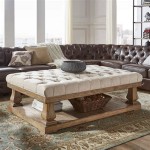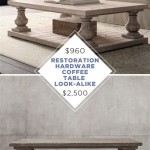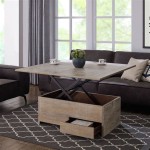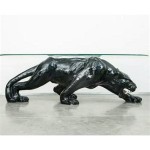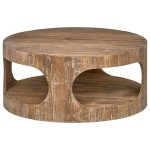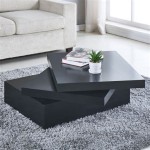How to Distress a Coffee Table with Chalk Paint and Paper Mache
Distressing furniture is a popular technique that adds character, history, and charm to pieces. This process involves creating the appearance of age and wear, making even new furniture look like a cherished antique. This article will guide you through distressing a coffee table using chalk paint and paper mache, two materials that provide unique textures and effects.
Understanding Chalk Paint and Paper Mache
Chalk paint is a versatile and forgiving paint known for its matte finish and ability to adhere to various surfaces. Its key advantage for distressing is its tendency to chip and flake with minimal effort, allowing for easy creation of authentic-looking wear. Conversely, paper mache, a mixture of paper pulp and adhesive, offers a textured surface that can be sculpted and distressed to create unique, one-of-a-kind effects.
Using chalk paint and paper mache in conjunction allows for a multi-layered approach to distressing. The chalk paint provides the base color and chipped, aged appearance, while the paper mache can be used to create raised accents or textured areas that enhance the distressed look. Both materials are relatively easy to work with, making this project suitable for crafters of all skill levels.
Preparing the Coffee Table
Before embarking on the distressing process, it's crucial to prepare the coffee table properly. This involves several steps:
- Clean the surface: Thoroughly clean the table using a mild detergent and water to remove any dirt, grease, or grime. Allow it to dry completely before proceeding.
- Sand the surface: If the table has a smooth finish, lightly sand the surface with fine-grit sandpaper to create a slightly rough texture that the paint will adhere to better.
- Prime the surface: Apply a coat of primer to seal the surface and ensure a smooth, even base for the chalk paint. This will create a better foundation for the distressed look and prevent the chalk paint from soaking into the wood.
Distressing with Chalk Paint
Once the primer is dry, you can start applying the chalk paint. This will determine the overall look of the distressed table.
- Choose your color: Select a color that complements your décor and personal style. Consider using a darker shade for the base coat, allowing the lighter accents and distressing to stand out.
- Apply the base coat: Using a brush or sponge, apply the chalk paint evenly to the entire table surface. Allow it to dry completely before moving on to the next step.
- Create distressed areas: This is where the magic happens. There are several ways to distress the chalk paint, and you can combine these techniques for a more pronounced effect. Here are some common methods:
- Sandpaper: Use sandpaper (medium-grit for more dramatic results) to lightly rub the edges, corners, and other areas where you want the paint to be worn away.
- Wire brush: This tool effectively creates scratches and texture for a more rustic look.
- Steel wool: Similar to sandpaper, steel wool can be used to create subtle distressed areas.
- Hammer: Use a hammer to create chipped areas by lightly tapping on certain sections of the table.
Adding Paper Mache Detailing
Paper mache allows you to create unique accents and textures that further enhance the distressed look of your coffee table. Here's how to incorporate it into your project:
- Prepare the paper mache paste: Mix paper pulp with a suitable adhesive (such as flour paste, wallpaper paste, or PVA glue). The consistency should be thick and malleable.
- Sculpting the paper mache: Apply the paper mache mixture to specific areas of the table, shaping it to create raised details such as knobs, decorative patterns, or even a textured surface.
- Leave to dry: Allow the molded paper mache to dry completely. This can take several hours or even overnight.
- Sand and distress: Once the paper mache is dry, use sandpaper or a wire brush to smooth out the edges, create texture, and distress the paper mache for a worn and aged look.
- Paint the paper mache: Apply a coat of chalk paint to the paper mache details, matching or contrasting the base color. Allow the paint to dry completely.
Finishing Touches
After the distressing and paper mache work is complete, you need to finish the coffee table to seal the paint and protect its distressed look. Here's how to do it:
- Apply a sealant: Use a sealant designed for chalk paint, such as a wax or polyurethane finish. This will protect the paint from scratches and wear, preserving the distressed look.
- Distress the sealant: After applying the sealant, you can lightly sand or distress it using fine-grit sandpaper to create a subtle aged look.
With the final touches applied, your distressed coffee table is ready to be enjoyed. This unique piece will add a touch of vintage charm and personality to your home, making it a focal point for your décor. Remember to experiment with different distressing techniques and paper mache accents to create a piece that truly reflects your own style and creativity.

Coffee Table Makeover With Chalk Paint

Easy Chalk Paint Coffee Table Makeover You Need To See Sunnyside Home

How To Whitewash Distress Furniture Diy Farmhouse Coffee Table

Chalk Paint Coffee Table Makeover Step By Diy Guide Bricks N Blooms With Stacy Ling

The Beginner S Guide To Distressing With Chalk Paint By Annie Sloan Thinking Closet

Chalk Paint Coffee Table Makeover Amy S Art

Easy Chalk Paint Coffee Table Makeover You Need To See Sunnyside Home

The Beginner S Guide To Distressing With Chalk Paint By Annie Sloan Thinking Closet

Chalk Paint Coffee Table Makeover Amy S Art

So Distressing 6 Ways To Distress Furniture Finding Silver Pennies
Related Posts

